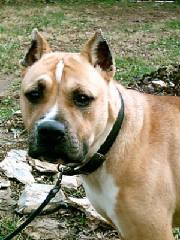
|
You won't believe this follow-on post from the Sunday, February 19, 2006 post titled, They Just Terrify Me. While out walking on the afternoon of Thursday, July 27, in Mill Park, a northern suburb |
|
of Melbourne, 82 year-old, Antonio Olalla was attacked by a battle-scared pit bull terrier as it killed Mitch, one of his two small Maltese terriers. The pit bull mauled Mr Olalla's arms and hands as he tried to save Mitch. The Herald Sun reports that a neighbour saved Mr Olalla's life by beating the dog with a stick during the savage attack. But what's really scary about this particular dog attack is what followed......
The dog left Mr Olalla bleeding and followed his scent to his home, walked through an open door and attacked Mr Olalla's 81-year old wife, Maria. Mrs Olalla heard the dog and thought it was either Mitch or Bianca, their small Maltese terriers but when she turned around she saw the savage pit bull. The dog cornered Mrs Olalla in her kitchen however she managed to escape and ran into a neighbours house. Can you visualise that? It would make a great movie scene! I can hear that Jaws type music! |
|
| It seems that there isn't a day that goes past without hearing or reading about a dog attack somewhere. Early in July a Staffordshire cross bit off the ear of a 5-year old girl in an attack in Palm Beach on the Gold Coast, Queensland. Then, as reported in the Sydney Morning Herald, July 10, 2006, the second dog attack on a child in three weeks occurred when a two-year-old toddler was |

|
|
badly hurt when attacked by a large Japanese Akita, a powerful, solid, well-proportioned and distinctive looking dog (the image above is of an Akita). Police said that the dog had escaped from a house 100m away. The toddler was seriously injured by the dog on Wallworth Road, Horsley Park and was taken to Liverpool Hospital and then transferred to Children's Hospital at Westmead, where he was checked for internal injuries. Then there's the report in The Age of an 11-year old boy hospitalised after being mauled by two dogs in far north Queensland. The police reported that the young boy was walking with a group of children in the Cairns suburb of White Rock when the attack occurred. The dogs' owner opened the gate to a yard and the two dogs, one a bull terrier-blue Heeler cross and the other a Staffordshire bull terrier-blue healer cross, rushed out towards the children and attacked the young boy who suffered cuts to his head and neck. The boy was taken to Cairns Base Hospital. Laws in the Australian state of New South Wales restrict certain breeds of dogs but there are calls to review the laws and the list of restricted dogs. According to a August 15, 2006 report in the Herald Sun, while in the state of Victoria there are 470 pit bull terriers registered (not many when you think about it), there are some 5,500 other deadly pit bulls and pit bull crosses not listed! Despite the fact that by law, pit bulls have to be desexed, housed in child-proof and escape-proof back yard enclosures, and be muzzled and leashed at all times in public, vicious pit bull attacks continue to occur. Why? Councils have the power to seize and destroy any unregistered pit bulls however, the problem according to Dr Graeme Smith, the General Manager of Lost Dogs' Home, is that many owners were using a loophole in the legislation to avoid detection. While by law, pit bull terriers have to be desexed, housed in child-proof and escape-proof back yard enclosures, and leashed and muzzled at all times in public, he said that to avoid having to comply with the tough law covering pure-bred pit bulls, many owners simply registered their vicious pit bulls as cross-breeds. Dr Smith urged the Government to introduce legislation to ensure owners of pit bull crosses were also listed as restricted breeds. The Herald Sun report quotes Dr Smith as saying that "if you have got a pit bull terrier, it's bad news, but if you have a pit bull crossed with a bull mastiff or a rottie, it is an even nastier mix. They are dangerous." In the August 15, 2006 Herald Sun article, there's a report of how 9-year-old Liam Spiteri's face was mauled by a savage dog wrongly identified as a Labrador/Staffodshire terrier cross when it was actually an American pit bull terrier on a leash, but not muzzled!!! The young boy is now recovering in the Royal Children's Hospital after cosmetic facial surgery and faces further facial surgery in coming months. Imagine now what his attitude to dogs will be. More Recent Attacks:I decided to do a quick search of stories related to vicious dog attacks over the last 30 days. Here is just a snippet of what I found:
Finally:
|
|
